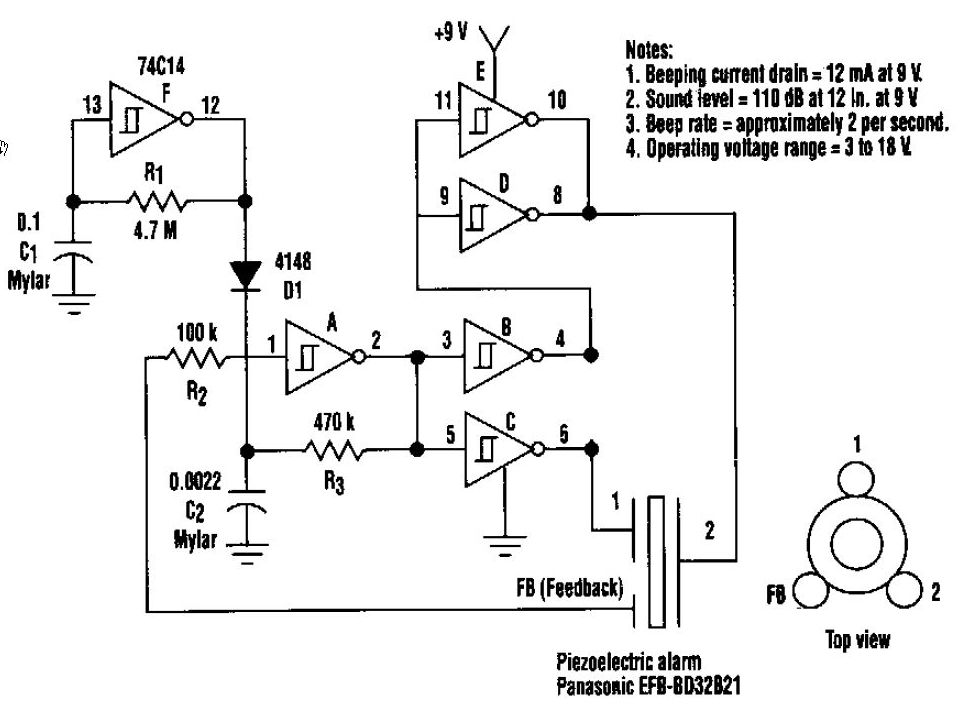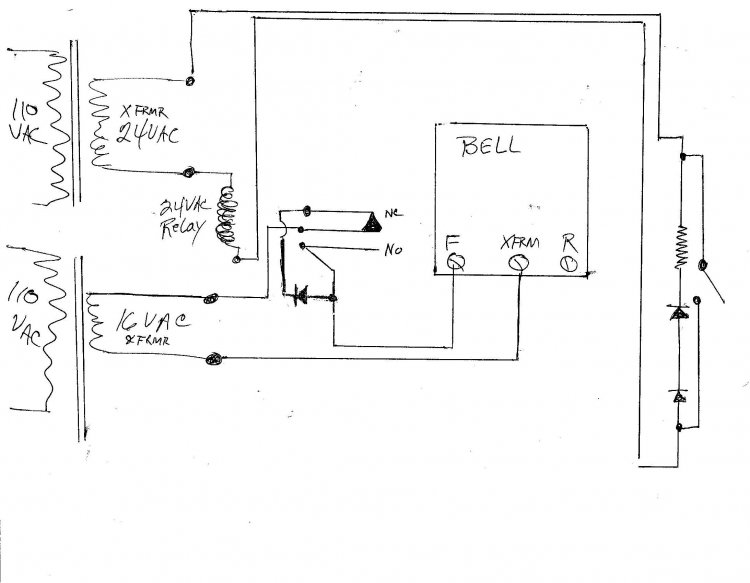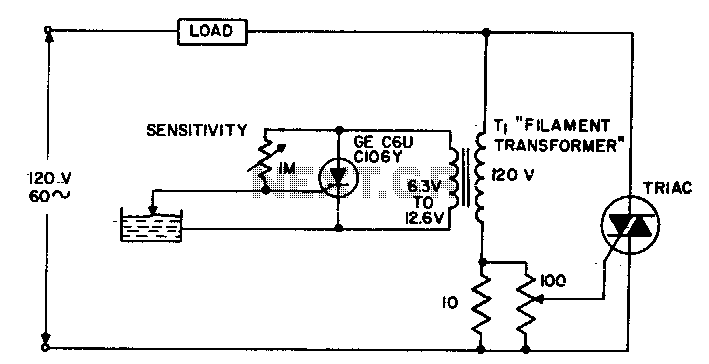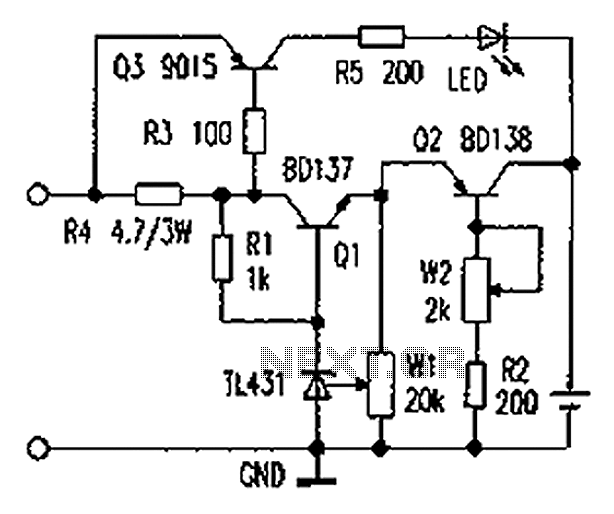
110dB Beeper Circuit

This beeper circuit generates an impressive 110dB sound level from a 9V supply. The design employs a single 74C14 (CD40106B) CMOS hex inverting Schmitt-trigger integrated circuit (IC), which must be paired with a piezoelectric device featuring a feedback terminal. This feedback terminal connects to a central area on the piezoelectric wafer. When the beeper operates at its resonant frequency, the feedback signal reaches its peak. One of the inverters in the 74C14 is configured as an astable oscillator, with a frequency set to be five times lower than the 3.2 kHz resonant frequency of the piezoelectric device. Feedback from the third pin of the beeper enhances the drive frequency, ensuring optimal sound output. The remaining four inverter sections of the IC are configured to create two separate driver circuits. The output from one section is cross-wired to the input of the second section, resulting in a differential drive signal that produces approximately 18V peak-to-peak when measured across the beeper. The final inverter section is set up as a second astable oscillator with a frequency of about 2 Hz, which controls the main oscillator's operation through a diode. To achieve a continuous tone, the modulation circuit can be removed.
The beeper circuit operates effectively by utilizing the properties of the 74C14 CMOS IC, which provides robust performance in generating square wave signals suitable for driving piezoelectric devices. The astable oscillator configuration allows for continuous oscillation, which is crucial for producing sound. The choice of operating frequency, specifically set to five times lower than the resonant frequency of the piezoelectric element, maximizes sound output due to resonance effects. The feedback mechanism is essential for stabilizing the oscillation frequency, ensuring that the piezoelectric device operates efficiently.
The cross-wiring of the inverter sections introduces a differential drive signal, which enhances the voltage swing across the piezoelectric element, thus increasing the sound pressure level generated. The additional astable oscillator serves a dual purpose; it can modulate the sound output at a lower frequency, providing a pulsing effect if desired. However, for applications requiring a steady tone, the modulation can be bypassed by eliminating the associated circuitry.
This circuit design showcases the versatility of CMOS technology in audio applications, particularly in generating high-decibel sound levels from a compact and efficient setup. The careful consideration of frequency, feedback mechanisms, and drive configurations contributes to the effective performance of the beeper circuit, making it suitable for various signaling applications.This beeper circuit will generate an car-splitting 110dB from 9V. The setup uses a single 74C14 (CD40106B) CMOS hex inverting Schmitt-trigger IC, which must be used with a piezoelectric device with a feedback terminal. The feedback terminal is attached to a central region on the piezoelectric wafer. When the beeper is driven at resonance, the feed back signal peaks. One inverter of the 74C14 is wired as an astable oscillator. The frequency is chosen to be 5 times lower thant the 3, 2KHz resonant frequency of the piezoelectric device. Feedback from the third pin of the beeper reinforces the correct drive frequency to ensure maximum sound output.
Four other inverter sections of the IC are wired to form two separate drivers. The output of one section is cross-wired to the input of the second section. The differential drive signal that results produces about 18Vpp when measured across the beeper. The last inverter section is wired as a second astable oscillator with a frequency of about 2 Hz. It gates the main oscillator on and off through a diode. For a continous tone, the modulation circuit can be deleted. 🔗 External reference
The beeper circuit operates effectively by utilizing the properties of the 74C14 CMOS IC, which provides robust performance in generating square wave signals suitable for driving piezoelectric devices. The astable oscillator configuration allows for continuous oscillation, which is crucial for producing sound. The choice of operating frequency, specifically set to five times lower than the resonant frequency of the piezoelectric element, maximizes sound output due to resonance effects. The feedback mechanism is essential for stabilizing the oscillation frequency, ensuring that the piezoelectric device operates efficiently.
The cross-wiring of the inverter sections introduces a differential drive signal, which enhances the voltage swing across the piezoelectric element, thus increasing the sound pressure level generated. The additional astable oscillator serves a dual purpose; it can modulate the sound output at a lower frequency, providing a pulsing effect if desired. However, for applications requiring a steady tone, the modulation can be bypassed by eliminating the associated circuitry.
This circuit design showcases the versatility of CMOS technology in audio applications, particularly in generating high-decibel sound levels from a compact and efficient setup. The careful consideration of frequency, feedback mechanisms, and drive configurations contributes to the effective performance of the beeper circuit, making it suitable for various signaling applications.This beeper circuit will generate an car-splitting 110dB from 9V. The setup uses a single 74C14 (CD40106B) CMOS hex inverting Schmitt-trigger IC, which must be used with a piezoelectric device with a feedback terminal. The feedback terminal is attached to a central region on the piezoelectric wafer. When the beeper is driven at resonance, the feed back signal peaks. One inverter of the 74C14 is wired as an astable oscillator. The frequency is chosen to be 5 times lower thant the 3, 2KHz resonant frequency of the piezoelectric device. Feedback from the third pin of the beeper reinforces the correct drive frequency to ensure maximum sound output.
Four other inverter sections of the IC are wired to form two separate drivers. The output of one section is cross-wired to the input of the second section. The differential drive signal that results produces about 18Vpp when measured across the beeper. The last inverter section is wired as a second astable oscillator with a frequency of about 2 Hz. It gates the main oscillator on and off through a diode. For a continous tone, the modulation circuit can be deleted. 🔗 External reference





